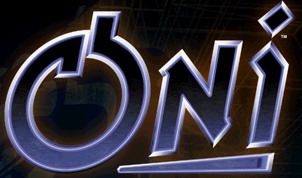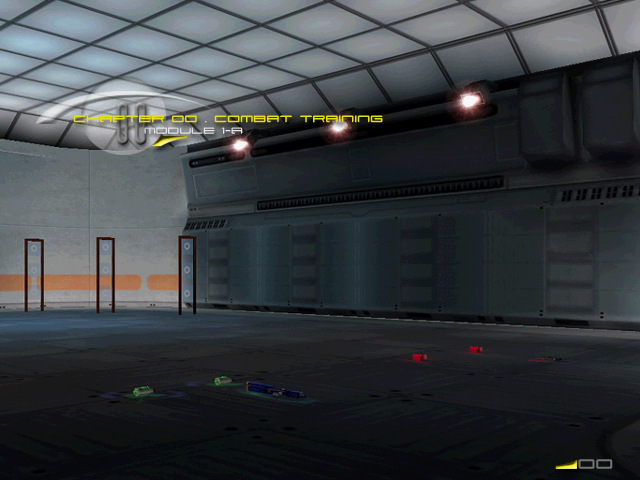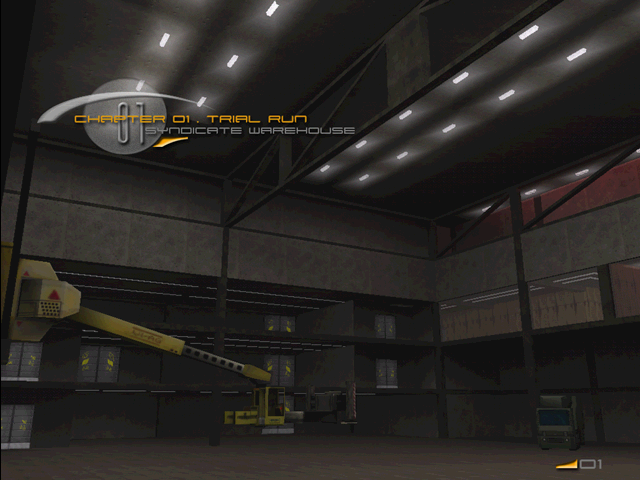Part 1: Short Essays for Levels 0 and 1.

(This links to the Opening Cutscene)

(This links to the Training Level)
Talking about Oni leads to one piece of subject matter that was baked into the game from the very start. That being the absolutely robust and well-programmed melee combat system.
As long as you're not on stairs, that is.
The melee in this game was a developmental drawing point, showing off Bungie West's skills as well making the game fun to play. In both regards, they succeeded. The combat is smooth, fluid, and practically without flaw. You can jump into a fight and back out with little issue beyond your own reflexes, and while you don't need to utterly master the combat system, there are things there for everyone.
The secret behind this was how the game Tweens, or Interpolates combat. With a lot of games, the programmers preset motions for their actors on screen. During many interviews with developers for other games, I hear a lot about the effort that goes into making sure everything moves right or looks proper in motion.
However, a freeform brawler like Oni, as Bungie's developers soon realized, would have far too many potential interactions to properly pre-model and pre-program into the game. So their solution was novel and while CPU intensive for the time, formed the backbone of a combat system that hasn't been matched since.
You see, the developers modeled certain 'key' actions. A Running loop, for example, or walking, or punching. Then, they taught their game to 'interpolate' animations between these key pre-programmed motions. By using a system normally designed to interpret motion between keyframes of animation, and applying it on a larger scale, Oni's engine is designed to smoothly transition from action to action without interrupting the flow of animation.
For example, when running towards an enemy, then entering into a slide-kick, a normal engine would stop the running animations and start the sliding ones once the keypress is received. For Oni, however, the engine looks at where it is in the 'run' animation sequence, looks to where the 'slide' animation starts, and then on-the-fly creates via the skeletal animation of all involved, an animation that transitions from 'run' to 'slide'.
Now, some animations are locked against each other, like how you can't go from a jump-flip into a flying kick, but for the most part, the system works, and works beautifully.
Moving on from under-the-hood mechanics, the combat style itself is quite simple. You have a Punch, a Kick, the four motions, Jump and Crouch. Everything you do in a fight is the end result of these eight potential inputs. As the Tutorial explains, the most basic strikes, the punch and kick, are gateways to quite a few options in terms of attacking, and I'll cover a couple of them here.
(P+P+P) The three hit punch is the fastest 'full' combo in the game, dealing moderate damage, and knocking down the enemy with the last hit. Unlike many other combinations, the game's interpolation allows you to move from one enemy to another mid-combo without breaking stride. It, along with (P+P) are my mainstay moves for the entire game.
(Hold C, Release + Punch) The Rising Fury is the first 'Super' move unlocked by Konoko over the course of the game, though the Anniversary Edition removes that limitation as part of the general modding it does. Like all her super moves though, this one is all flash and very little substance. I find the range to be not worth it, and the Fury - along with the Super Kick - both start from a crouching position, effectively locking you into a place in a game where mobility is vital.
(K+K) The Two-Kick combo has Konoko's longest-range and is the heaviest two-hitter she has, moreso than the P+K. I don't like it as the timing is just off to me, and I feel it leaves her to open to counter attacks in the process. The three hit version, the (K+K+K), has some very awkward timing on the last kick that I can't seem to put into my muscle memory.
But these comments, as well as the ones I made in the video itself, lead me to one conclusion. That Oni's fighting engine has the pacing and style of a 2D fighting game like Street Fighter. The combination of button presses, of maneuvering, of priority and hit-boxes all give me the feel of a character from Street Fighter being transplanted into a 3d action game. And this creates just a little bit of dissonance in my mind as I have to fight between my rather poor skills in Fighting Games, with my better, but not perfect skills in this game.
On the other side of the spectrum, the gunplay is this game is practically the definition of the Trope "Boring, but Practical". Guns by definition have a range that Konoko doesn't have, and they are a great way to peel off health or put down enemies at range before you are forced into melee.
For the most part, I will cover guns in the video, but I want to talk about the Pistol here. While the name is different, the standard issue TCTF sidearm is a very good ringer for the AUTO-9 pistol used by Robocop. Except this one is semi-auto, and Konoko lacks the wrist strength to counteract the huge recoil from each shot.
You actually see me use the recoil to my advantage in training, lining up the first shot so that the recoil will let me hit the next target. In actual practice though, this gun is either used at short range to put two to three shots into someone before they kick you, or at longer ranges where you have time to line up your shot and whittle their health down. After all, even the weakest Brown/Green Striker takes at least 4 shots to put down.
And the guns only get better from here.

(This links to Level 1)
The first actual level of the game, Trial Run, introduces us to most of our core cast of characters. Konoko, Shinatama, Kerr and Griffin. Their interactions, or lack thereof are quite telling, and it demonstrates just how much of a Beta that this game was when it was released. To whit, the complete lack of interaction between Konoko and Kerr seriously hobbles later plot points. Having them talk here, to have Ker encourage Konoko or for her to react more emotionally in a positive manner to him rather than her talks to Griffin would have gone a long way to helping flesh out both of them.
In fact, note to self, by the end of the game, doodle up a character interaction map.
Konoko is presented as something of an aggressive go-getter from the start, eager to do her job and look good for Griffin. On the other side of things, Shinatama is calm, collected and she... talks... so.... slowly.
At first, I thought it was annoying, but then later on, I realized that Shinatama spoke in that cadence to directly counter-balance Konoko's own faster speech and action tendencies. Shinatama is also playing a very delicate game between being loyal to Griffin and trying her best to help Konoko, and it shows with how she addresses both of them. But Shinatama is always trying to slow Konoko down, for a lot of reasons, some of which won't be apparent until the end-game.
But from there, this game is still firmly in the hand-holding stage. While Level 0 introduced combat, Shinatama actually takes control away from us in order to exposit on the health system and the F1 menu. It's annoying, but I can live with it for the most part.
The UI is well designed in its minimalism, and while being limited to 6 Energy/Kinetic/Hypos at once will be annoying at points, it's a good choice. The navigation aid is unobtrusive and points you where you need to go without interrupting your view of the action.
In addition, the ease to which the player is introduced to combat is well organized. Simple civilians first, including the option to drop and ambush an unsuspecting worker gets the player used to getting close, or just shooting from range.
Something I don't mention is that a lot of the enemies in the level don't actually start with full health. Enemies I take out in two hits in this level require three or even four later on, and this again helps ease the player into the combat without overwhelming them.
Yet, there is one subject I talked about that requires elaboration.
Bungie went into this game with some goals in mind, and one of them was to explore the concept of fighting in real-world spaces. To that end, they retained the services of an actual architect, or a architectural firm to give basic guidelines for design and use-of-space.
Unfortunately, I can't prove that anymore. I'll see about digging through my Computer Gaming Magazines from 98 to 2001, during the game's development cycle and see if I can figure that out.
But regardless of the source, the end result were levels that looked like they could have been used for something, but are completely devoid and empty of practical use. Here, we travel through warehouses, and given that I work in one in real life, seeing that makes me hurt inside. The open spaces are great for fighting in and through, but are utterly wasted in terms of storage and profit. There aren't even proper access between rooms to move cargo around, and everything about it is just wrong!
Spaces were designed, but real life is (thankfully) not a video game, meaning that in the end, what was developed had to be redone to make for viable gameplay. In essence, all these spaces would, in real life, be about 1/2 the size in each direction. There would be safety bars everywhere, and the tight confines would utterly change the dynamic and flow of the game.
There would also be more things around, as the world is pretty lifeless for the most part. Shame, really. I would have loved to have done actual stealth sections through an office space, or follow a target through a crowd of people leading to an epic fight in an open space as the civilians run in terror.
But such was not to be.